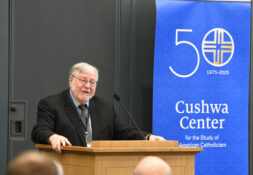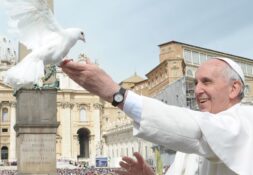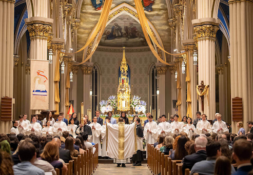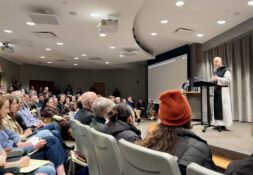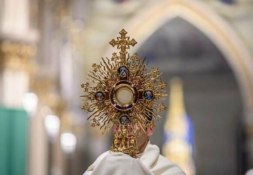26 Sorin Fellows pilgrimage to Italy with dCEC staff
The de Nicola Center for Ethics and Culture (dCEC) hosted a fall-break opportunity for select members of its student Sorin Fellows Program: a week-long pilgrimage to Italy. Pilgrims visited holy sites in Orvieto, Assisi, and Rome.
“The Center can think of no more authentic way to search for truth, beauty, and goodness than to walk in the footsteps of the earliest disciples and saints,” dCEC Associate Director for Operations Laura Gonsiorek told the Rover.
The pilgrimage began in Orvieto with a Mass in the crypt of the Duomo di Orvieto. The cathedral houses the blood-stained corporal of a thirteenth-century Eucharistic miracle, upon which a consecrated host seeped blood. This Eucharistic miracle prompted Pope Urban IV to institute the Feast of Corpus Christi into the liturgical calendar.
Then the pilgrims made their way to Assisi, the birthplace of both St. Francis and St. Clare. They venerated the San Damiano Crucifix that famously spoke to St. Francis and even walked through the “decision door” that St. Francis walked through when he renounced his worldly life and embraced poverty.
Additionally, they visited the glass casket of Bl. Carlo Acutis, a boy who died in 2006 at age 15. Several pilgrims told the Rover venerating his incorrupt body was a highlight of their trip. Janey Olohan wrote, “I’d never seen anything like that, and it was one of the most incredible experiences of my life … he was so young, led such a holy life, and looked so alive.”
Next, they proceeded to Rome, where they held fistfuls of religious items to be blessed by Pope Francis at his Wednesday audience. They also met with a representative from the Dicastery for the Doctrine of Faith, visited the Wisdom of Faith Community, and climbed the Scala Santa—the stairs Jesus climbed during His Passion. dCEC staff member Margaret Cabaniss told the Rover, “In a concrete way, climbing the Scala Santa on your knees, or going to adoration on little sleep after a long day of walking, is hard! Those small mortifications are part of our training for growth in the spiritual life.”
Cabaniss explained, “Pilgrimages can be equally uplifting and challenging in unexpected ways, with crosses and graces appearing where one might not expect. The more students can enter into those experiences prayerfully, with humility and openness to the Spirit, the more they can serve as opportunities for growth in faith and devotion.”
Students not only grew spiritually, but intellectually. Several tours were arranged, including of Rome’s four major basilicas, the catacombs of St. Callixtus, and ancient Rome. Students took a particular interest in the after-hours, private tour of the Vatican Museums led by art historian Elizabeth Lev. Junior Hannah Smith told the Rover, “Liz Lev’s tour of the Vatican Museums and Sistine Chapel seamlessly wove theology, history, and humor together to explain the history of the Church in Rome through beauty.”
Pilgrims also had ample free time to explore the city by themselves or in small groups. Since Rome has over 900 churches, many pilgrims found themselves stopping in several churches a day. Ana Reyes noted the pervasiveness of tombs within the churches and found beauty in them: “I could not help but reflect on the number of tombs we walked past while in churches. More than an acceptance of our mortality, I felt as though there was almost a celebration of death because it is a necessary step towards eternity with God.”
Fr. Brian Ching C.S.C. accompanied the students on the pilgrimage as chaplain. He told the Rover, “[We] place ourselves very deliberately in the presence of holy people and holy things that call us out of the day-to-day monotony of our own spiritual life and into deeper reflection on our role within the Church universal, our understanding of the Church universal, [and] our understanding of our current place in the history of the Church.”
When asked about the highlights of the trip, Fr. Ching noted, “just being around the Sorin Fellows is always a highlight.”
dCEC Student Formation Program Manager David Younger said, “One of my favorite parts of working with Sorin Fellows is that they want to be formed by their faith and belief in the mission of the University…[the] driven nature of the Sorin Fellows provides even more motivation for me to not only work hard on their behalf to provide numerous opportunities for the fellows, but to also be challenged by their striving for holiness as well.”
When asked why pilgrimages are part of student formation, Younger responded, “These pilgrimages provide fellows the opportunity to encounter the rich spiritual heritage of the Catholic Church around the world while also still providing for the intellectual heritage made possible through education and discussion and tours.”
dCEC Associate Director for Operations Laura Gonsiorek explained that all of the center’s programming is made possible through generous benefactors: “These extraordinary individuals and families not only champion the mission and work of the Center more broadly but also recognize that Notre Dame’s students are the jewel in the crown of the university and the lifeblood of the de Nicola Center. We were delighted to carry them and their intentions with us on pilgrimage.”
In an interview with the Rover, sophomore Kathryn Bowers expressed gratitude: “I have been blessed by seeing beauty, visiting holy sites, and having time to pray and reflect on my faith life and relationship with God.”
The de Nicola Center continues to host Catholic programming for students throughout the semester, including their annual conference November 10–12.
Madeline Murphy is a sophomore studying music and theology. She is currently battling the post-pilgrimage mystery illness and requests Ibuprofen and prayers. Please send questions or comments to mmurph64@nd.edu.
Photo Credit: de Nicola Center for Ethics and Culture
